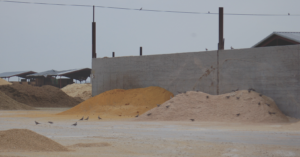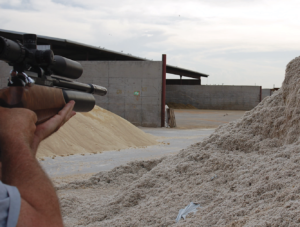The author switches over to the Walnut stocked FX Royale air rifle for a while, and continues to stack up birds at the dairy farm. (Photo: Jim Chapman)
I’d been in Arizona on business for a few days and had the chance to catch up with a couple of my friends who lived in the area. As we were shooting the breeze they asked if I’d like to go along on a pest control shoot at a local dairy farm the next morning. These places get hit hard by pest birds: feral pigeons, Eurasian collared doves, and starlings occur in huge numbers.
They also are infested by morning doves, though these are off limits to airguns and when out of season. The place where we’d hunt the next morning tended towards pigeons, and the guns I opted to take along were the FX Royale in .25 and the Daystate Airwolf .25. Both rifles are superb examples of European design and build quality (Daystate is British and FX is Swedish), offering those attributes required in a hunting rifle: accuracy, power, reliable multi-shot capacity, high shot count, and great ergonomics.
I rolled up to the designated meeting point at sunrise and met my friends Robert and Kip, and then the three of us loaded up our gear in Roberts truck and we hit the road for the 40-minute drive to the dairy. We’d all shot here before, it is the largest dairy farm in the state, and is much busier and more industrialized than most of the other farms I hunt.
The layout of this property does not offer much cover, but the pigeons are acclimated to people, so long as they keep their distance. Their tolerance seems to be set at about 60 yards, anything closer and they take off! Lots of birds could be seen, mostly pigeons, with a few Eurasian collared doves in the mix.
I still haven’t come up with an explanation, but at some of the dairies it will be almost all feral pigeons, at the next it will be almost all Eurasian doves, and at a few it there will be an equal mix. And there will often be a large presence of starlings and blackbirds as well. I’ve not worked out the basis of this segregation, but the outcome is the same at all of them, large quantities of food taken, and deposits of droppings left behind.
About the Air Rifles
The Daystate Air Wolf is a bottle forward design: this one was a .25 caliber generating 45 fpe and could knock the antennae off a gnat at 75 yards. The rifle is mechanical perfection dressed in a handpicked walnut stock. I was scared to death I was going to scratch it, my reputation for being brutal on guns is not without merit. For pellets I used the JSB 25.3 grain Exacts, which is the preferred fodder for this rifle and one that offers great terminal performance.
The FX Royale was my other rifle of choice: it is another almost perfect hunting rifle that has the air bottle up front, a truly outstanding trigger, reliable and fast cycling sidelever action in a robust and ergonomic walnut stock. The FX rifles are powerful and have a well-deserved reputation for accuracy. There is a reason they are always well represented in long range benchrest competitions. The ammo preferred by this rifle was the 25.4 grain FX roundnose Diabolo pellets.
I’ve been asked why we use high power guns when hunting lighter bodied quarry. It is not that high power is required to cleanly kill small game, but rather that we often shoot at ranges out to 100 yards or a bit further. Usually I like to get in close to my quarry, however, for some species and some situations the longer shot is more practical. When you have a heavy .25 pellet traveling at over 900 fps, it flattens the trajectory as a result of the retained (high) velocity along its path of flight.
Further, these heavy and fast moving pellets are less susceptible to wind. The last point is that when taking longer shots at birds, the combination of head movement and time of flight can make headshots sketchy. Body shots can be a better option for long range work and a heavy, large caliber produces a substantial impact that ensures a clean kill with a little more latitude in placement.
Steady Action on the Hunt
Arriving at the dairy we parked and went out on foot, as the morning began to warm up. Working our way along the outbuildings and feed bins, we found pigeons on the ground, on wires, the roof, and lined up on the fences in moderate numbers. Not the hundreds of birds we sometimes see, but still groups of 15-25 birds everywhere we looked. And true to form they had zero tolerance for us getting inside of their safety zone. We didn’t carry shooting sticks, opting instead to either shoot offhand or (most frequently) using nearby structures as makeshift rests. I consider myself a decent offhand shot but going for headshots on pigeons at 60 yards requires all the stability you can achieve!
At one point I peeked around a corner of a shed and saw about 20 pigeons spread out on the side of a grain pile, feeding and unaware of my approach. I leaned against the wall and braced myself, squeezing off the shot. The first bird slumped over as the rest of the small flock jumped up and then settled down again. “Thwack.” The second bird rolled over and this time his flock mates took off, some landing on a nearby metal roof with the rest beating it for parts unknown. I heard a muffled report from one of the other rifles and watched another bird tumble off the roof.
Moving along I dropped to a knee and took another bird off a fence rail. We had to pass on many of these flying rats, because they were sitting on fences and roofs without a safe backdrop behind them. After a short break to rehydrate, one of the guys went back to the truck and swapped his rifle for an FX Ranchero handgun, which was set up to generate 22 fpe and zeroed for 35 yards. He then slipped inside the barn carrying the Ranchero at the ready. I have seen him put 10 consecutive shots into 1/2” at 40 yards with this PCP handgun, and he used it to good effect dumping pigeon after pigeon from the rafters.
We kept shooting until about noon, making a good show of it and bringing down a respectable number of birds. While I did not keep count, we collected the carcasses several times and I would estimate at least 20 birds on each pass, sometime quite a few more. This is another one of those settings where airguns are the most practical tool for the job; they are very accurate and generate much lower energy levels than our .22 rimfires. Additionally, the shrouded barrels make them so quiet we don’t disturb the livestock or the staff as we move through the farm.
After loading up the gear we made our way to a local Mexican restaurant, one of the authentic kitchens you only find in our Southwestern border states. We filled up on chili rellenos, empanadas, tamales and tortilla chips soaked in fiery salsa, chugged a couple ice cold drinks, and then well fed, rehydrated, and just a tad sunburned headed off, so I could prepare for the trip home.








